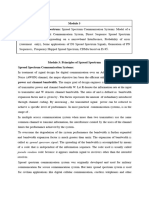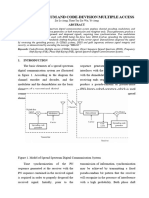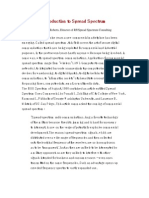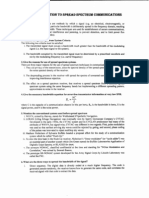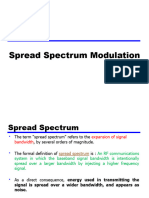Direct Sequence Spread Spectrum With Barker Code and QPSK: Saed Thuneibat
Direct Sequence Spread Spectrum With Barker Code and QPSK: Saed Thuneibat
Uploaded by
Adit SoodCopyright:
Available Formats
Direct Sequence Spread Spectrum With Barker Code and QPSK: Saed Thuneibat
Direct Sequence Spread Spectrum With Barker Code and QPSK: Saed Thuneibat
Uploaded by
Adit SoodOriginal Description:
Original Title
Copyright
Available Formats
Share this document
Did you find this document useful?
Is this content inappropriate?
Copyright:
Available Formats
Direct Sequence Spread Spectrum With Barker Code and QPSK: Saed Thuneibat
Direct Sequence Spread Spectrum With Barker Code and QPSK: Saed Thuneibat
Uploaded by
Adit SoodCopyright:
Available Formats
IOSR Journal of Engineering (IOSRJEN) www.iosrjen.
org
ISSN (e): 2250-3021, ISSN (p): 2278-8719
Vol. 06, Issue 06 (June. 2016), ||V1|| PP 62-67
Direct Sequence Spread Spectrum with Barker Code and QPSK
Saed Thuneibat
Department of Electrical Engineering, Al-Balqa Applied University, Jordan
Abstract: - Spread Spectrum technique is a digital passband technique. It uses a special code which is known
only to the transmitter and receiver of that message. The special code appears as a noise signal to the jammer
who tries to jam the channel. In this paper, we present the Direct Sequence Spread Spectrum. Firstly, we show an
overview of Direct Sequence Spread Spectrum, then, we simulate Direct Sequence Spread Spectrum using
MATLAB. The results of simulation are presented in this paper. We are clearly demonstrating the benefits of
Direct Sequence Spread Spectrum in a digital communication system in providing privacy and antijamming. The
simulation by MATLAB program simplifies the study, analysis and development of these techniques in modern
digital communication networks.
Keywords: - Spread Spectrum, DSSS, BPSK, MATLAB Simulation.
I. INTRODUCTION
In real communication system we have links with limited bandwidths. The wise use of these
bandwidths has been, and will be, one of the main challenges of electronic communications; the issue is
different in optical communications. However, the meaning of wise may depend on the application. Usually, we
need to combine several low bandwidth channels to make use of one channel with a larger bandwidth.
Sometimes we need to expand the bandwidth of a channel to achieve goals such as privacy and antijamming.
There are two broad categories of bandwidth utilization: multiplexing and spreading. In multiplexing, our goal is
efficiency; we combine several channels into one. In spreading our goals are privacy and antijamming; we
expand the bandwidth of a message signal to insert redundancy, which is necessary to achieve these goals.
In literature, last years, a number of research papers have been published. In [1], authors compared
between Frequency Hopping Spread Spectrum (FHSS) and Direct Sequence Spread Spectrum (DSSS) in terms
Bit Error Rate (BER) as the performance parameter for the comparison. It was found that DSSS with different
sequence codes provides better BER than FHSS. Paper [2] discussed various techniques like Direct Sequence
(DS), Frequency Hopping (FH), pseudorandom noise (PN) sequences. MATLAB simulation is performed and a
comparative study among various techniques is achieved. For comparison the parameters discussed are error
probability, noise, power spectral density, error rate performance, interference and bandwidth. Authors
concluded that Spread Spectrum (SS) techniques become more and more popular. DS and FH are the two major
methods of SS. They have different strongpoint and are equally important. M-sequence and Gold-sequence have
almost the same performance with single information transmission. However, the multi-user situation is
demanded now days.
In paper [3], MATLAB Simulink software was used to design and simulate the operation of
equivalent base-band binary phase shift keying (BPSK) and DSSS system. The performance evaluation was
tested by simulating the design to get the received data which compared with transmitted data, and also to study
the effect of additive white Gaussian noise (AWGN) and calculate BER. The simulation results shows that the
performance of the system in presence of AWGN is better when using Integrator and Dump in active correlator
than using digital LPF in active correlator.
II. SPREADING SPECTRUM TECHNIQUES
SS is a modulation method that spreads narrow band signals over a wide range of frequencies at the
transmitting end and then dispreads it into the original data bandwidth at the receiving end [4]. The SS
technique increases the bandwidth of the transmitting signals to a value much larger than is needed to transmit,
thus, if the required bandwidth for each station is B, SS expands it to B ss [5], Such that Bss>>B, as shown in
figure 1. The expanded bandwidth allows the source to wrap its message in protected envelope for a more
secure transmission.
International organization of Scientific Research 62 | P a g e
Direct Sequence Spread Spectrum with Barker code and QPSK
Fig. 1: spread spectrum
Based on the kind of spreading modulation, spread spectrum systems are broadly classified as: FHSS, DSSS
and Hybrid spread spectrum systems (HSSS).
FHSS is a transmission technology used in wireless networks. Its a technique uses M different
carrier frequencies that are modulated by the source signal, through frequency shift keying modulation (FSK)
scheme. At one moment, the signal modulates one carrier frequency; at the next moment, the signal modulates
another carrier frequency. Although the modulation is done using one carrier frequency at a time, M
frequencies are used in the long run. The bandwidth occupied by a source after spreading is B FHSS>>B.
The general layout for FHSS, explained in figure 2. A PN code creates a k-bit pattern for every
hopping period (Th). The frequency table uses the pattern to find the frequency to be used for this hopping
period and passes it to the frequency synthesizer. The frequency synthesizer creates a carrier signal of that
frequency and the source signal modulates the carrier signal.
Fig. 2: FHSS.
Figure 3 illustrates the principles of FHSS. In this case, M is 8 and k is 3. The PN code generator will
create 8 different 3- bit pattern which are mapped to different frequencies in the frequency table.
Fig. 3: Frequency selection in FHSS.
When the hopping sequence is completed, it is then repeated, and this process continues until the
information being communicated has been transferred. Additionally, a dwell-time is specified, which
determines how long each frequency will be utilized before hopping to the next position in the hopping
sequence; as shown in figure 4.
International organization of Scientific Research 63 | P a g e
Direct Sequence Spread Spectrum with Barker code and QPSK
Fig. 4: FHSS cycles.
DSSS methods are the most frequently used spread spectrum technique and explained in the next
sectioIf we are really paranoid about being eavesdropped, we can take further steps to make signal difficult to
find. A commonly used example is that of a HSSS using both FH and DS techniques. Such schemes typically
employ FH of the carrier wave, while concurrently using a DS modulation technique to modulate the data
upon the carrier. In this technique an essentially DS modulated message is hopped about the spectrum, Figure
5 illustrated this technique. To successfully intercept such signal, first crack the FH code, and then crack the
DS code. If we want to be further secure, we encrypt data stream with a very secure crypto code before feed
into DS modulator, and employ cryptographically secure PN codes for the DS and FH operations. The
eavesdropper then has to chew his way through three levels of encoding. Such a scheme is used in the military
systems.
Fig. 5: A hybrid DS-FH spreading scheme.
III. DSSS CONSEPT, APPIICATIONS AND BENEFITS
DS modulation is achieved by modulating the carrier wave with a digital code sequence which has a
bit rate much higher than that of the message to be sent. This code sequence is typically a PN code. In effect
we are transmitting a wideband noise like signal which contains embedded message data. In
telecommunications, DSSS is a SS modulation technique. SS systems are such that they transmit the message
bearing signals using a bandwidth that is in excess of the bandwidth that is actually needed by the message
signal. In DSSS, we replace each data bit with n bits using a spreading code. In other words, each bit is
assigned a code of n bits, called chips, where the chip rate is n times that of the data bit. Figure 6 shows the
concept of DSSS.
Fig. 6: Concept of DSSS.
International organization of Scientific Research 64 | P a g e
Direct Sequence Spread Spectrum with Barker code and QPSK
In military communications, interception of hostile communications is commonly used for various
operations such as identification, jamming, surveillance or reconnaissance. The successful interceptor usually
measures the transmitted power in the allocated frequency band. Thus, spreading the transmitted power over a
wider band undoubtedly lowers the power spectral density, and thus hides the transmitted information within
the background noise, as shown in figure 7. The intended receiver recovers the information with the help of
system processing gain generated in the spread process. However, the unintended receiver does not get the
advantage of the processing gain and consequently will not be able to recover the information. Because of its
low power level, the spread spectrum transmitted signal is said to be a low probability of interception (LPI)
signal.
Fig. 7: Buried SS signal under the noise level.
The transmitted information over the SS system cannot be recovered without knowledge of the
spreading code sequence. Thus, the privacy of individual user communications is protected in the presence of
other users. Furthermore, the fact that spreading is independent of the modulation process gives the system
some flexibility in choosing from a variety of modulation schemes.
In a multipath propagation environment, the receiver acquires frequent copies of the transmitted
signal, as shown in figure8. These signal components often interfere with each other causing what is
commonly described as signal fading. The resistance of the SS signals to multipath fading is brought about by
the fact that multipath components are assumed to be independent. This means that if fading attenuates one
component, the other components may not be affected, so that unfaded components can be used to recover the
information.
Fig. 8: Illustration of multiple paths.
As the signal is spread over a large frequency-band, the Power Spectral Density (PSD) is getting very
small, as explained by figure 9.
Fig. 9: Power and frequency in SS.
The biggest demerit of using a SS technique is the complex circuitry involved in generation and
reception of spread signal waveforms. These results Increased cost of operation and maintenance. SS involves
using a larger bandwidth than that required to transmit the information. Thus the technique is inherently
bandwidth inefficient. But these disadvantages might be very nominal considering the unique advantages that
SS provides under certain conditions.
International organization of Scientific Research 65 | P a g e
Direct Sequence Spread Spectrum with Barker code and QPSK
Figure 10 depicts transmitter, channel and receiver of DSSS system. In the transmitter stage, the
baseband data signal m(t) is spread using PN-Sequence c(t) [6]. Then, the resultant spread signal s(t) is applied
to BPSK modulator. The output signal of the BPSK modulator x(t) is transmitted over AWGN channel.
Accordingly, transmitted signal is thus a direct sequence spread binary phase-shift-keyed (DS/BPSK). In the
receiver, the received signal is demodulated using coherent detector and is then multiplied again by the same
(synchronized) PN code. Another observation is that the despread operation is the same as the spread
operation.
Fig. 10: Spreading and despreading in DSSS.
IV. SIMULATION RESULTS
Based on the above information, we had developed a MATLAB cod for the simulation of DSSS [7].
Several runs of the developed program were performed. The results of simulation are presented in figures from
11 to 16.
Figure 11 shows the message signal as an input to DSSS. This signal is encoded by polar NRZ. The
original may be one of the following three types of information; analog multimedia traffic, for example voice
and video, alphabet numerical data from keyboard and digital files from a memory.
Fig. 11: Message signal.
There are different code sequences that can be used with DSSS scheme. Gold Sequences and Walsh
Codes may be used as the pseudorandom codes for transmission. In this paper, for the simulation we used
Barker code. 11 bit Barker code is encoded by polar NRZ, one example is shown as encoded sequence in
figure 12.
Fig. 12: Barker code.
The spreaded signal by DSSS is a result of multiplication of original signal by the Barker code
sequence and shown in figure 13.
International organization of Scientific Research 66 | P a g e
Direct Sequence Spread Spectrum with Barker code and QPSK
Fig. 13: Spreaded signal.
Usually, the DSSS spreaded signal is band passed using BPSK modulation technique for the transmission over
wireless transmission media. BPSK modulated signal is shown in figure 14.
Fig. 14: BPSK modulated signal.
At the receiver end, the signal is firstly demodulated as depicted in figure 15.
Fig. 15: Demodulated signal.
And finally despreaded by DSSS demodulator, figure 16 reflect the signal that was transmitted.
Fig. 16: Despreaded signal.
V. CONCLUSION
The goal of this paper is to explain and simulate the DSSS modulation using MATLAB environment to
simplify the analysis and design of this technique. Results of simulation are clearly demonstrates that the goal
is achieved.
REFERENCES
[1] .Vandana Nath and Abhishesh Kumar A Comparative Study of Spread Spectrum Technique Based
onVarious Pseudorandom Codes, Global Journal of researches in engineering, Volume 12, Issue 6,
Version 1.0, May 2012.
[2]. Vishal Sharma, Richa Sharma "ANALYSIS OF SPREAD SPECTRUM IN MATLAB" International
Journal of Scientific & Engineering Research, Volume 5, Issue 1, January-2014.
[3] Thamer M. Jamel and Sadiq K. Gharkan "Design and simulation PN synchronization of base band direct
sequencespreadspectrumDS/SSsystem"January2009 https://www.researchgate.net/publication/212116390
[4] ." Spread spectrum concept", 2000, http://www.labyrinth.net.au/~steve/papers/concepts.pdf.
[5] Behrouz A.Forouzan "data communications and networking", 4 th edition.
[6] S. Hykin,"Communication Systems", fourth edition ,John Wiley and Sons,Inc.,2001
[7] John Ga. Proakis and Masoud Salehi, Contemporary Communication Systems Using MATLAB.
International organization of Scientific Research 67 | P a g e
You might also like
- The Vampire King 47260925Document288 pagesThe Vampire King 47260925orazioNo ratings yet
- Simulation of Digital Communication Systems Using MatlabFrom EverandSimulation of Digital Communication Systems Using MatlabRating: 3.5 out of 5 stars3.5/5 (22)
- A Bluebook Guide For Law StudentsDocument21 pagesA Bluebook Guide For Law StudentsPrithvi Reddy100% (2)
- The Music of The Río de La PlataDocument16 pagesThe Music of The Río de La PlataEdit Selmeczi100% (1)
- Renault Kerax 440.35T Dxi 6X4 HD: WWW - Renault-Trucks - Co.ZaDocument4 pagesRenault Kerax 440.35T Dxi 6X4 HD: WWW - Renault-Trucks - Co.Zaentreprise.tgctp201560% (5)
- Lec 4-2 Spread Spectrum2Document27 pagesLec 4-2 Spread Spectrum2Ajmal EnsanahNo ratings yet
- Paper-4 - Simulation and Analysis of Spread Spectrum Techniques Using MATLABDocument6 pagesPaper-4 - Simulation and Analysis of Spread Spectrum Techniques Using MATLABRachel Wheeler100% (2)
- 21EC51 DC Module 3Document36 pages21EC51 DC Module 3adnagaprasadNo ratings yet
- DSSS BPSKDocument48 pagesDSSS BPSKEmy Jacob100% (2)
- Lecture 20 Direct Sequence Spread SpectrumDocument13 pagesLecture 20 Direct Sequence Spread Spectrumn4vrxcryNo ratings yet
- CH 7 Spread SpectrumDocument5 pagesCH 7 Spread SpectrumNitesh ChhabriaNo ratings yet
- Electronics 07 00170 PDFDocument18 pagesElectronics 07 00170 PDFRti RecNo ratings yet
- Literature Survey of Direct Sequence Spread Spectrum SystemDocument10 pagesLiterature Survey of Direct Sequence Spread Spectrum SystemDheyauldeen NajimNo ratings yet
- Wireless Technology Part 2Document24 pagesWireless Technology Part 2mijanursardar1999No ratings yet
- Gold Seq ProjectDocument23 pagesGold Seq ProjectMostafa ZakyNo ratings yet
- Maharashtra State Board of Technical Education 008Document12 pagesMaharashtra State Board of Technical Education 008Siddhart KadamNo ratings yet
- Implementation of Direct Sequence Spread E2aa21adDocument9 pagesImplementation of Direct Sequence Spread E2aa21adasrawi asparNo ratings yet
- Slide PresentationDocument7 pagesSlide Presentationaswani kpNo ratings yet
- Introduction To Spread SpectrumDocument8 pagesIntroduction To Spread SpectrumTim Kabi100% (1)
- Info Com 10Document9 pagesInfo Com 10the_arcmanNo ratings yet
- Sree Narayana Mangalam Institute of Management and Technology Maliankara.P.O., North Paravoor Ernakulam District, Pin: 683516Document6 pagesSree Narayana Mangalam Institute of Management and Technology Maliankara.P.O., North Paravoor Ernakulam District, Pin: 683516motturoshNo ratings yet
- Spread Spectrum and Code-Devision Multiple AccessDocument6 pagesSpread Spectrum and Code-Devision Multiple Accesszarleaung100No ratings yet
- Intro To Spread SpectrumDocument10 pagesIntro To Spread SpectrumOm Krishna PatelNo ratings yet
- Implementation of Spread Spectrum Modulation Schemes For Secure CommunicationsDocument5 pagesImplementation of Spread Spectrum Modulation Schemes For Secure Communicationsdonishakumar15No ratings yet
- Mod 3Document25 pagesMod 3Anmol GuptaNo ratings yet
- Spread Spectrum SystemsDocument17 pagesSpread Spectrum SystemsAnonymous H0SJWZE8No ratings yet
- DC Assignment 1Document6 pagesDC Assignment 1saurabhNo ratings yet
- Fpga Implementation of Direct Sequence Spread SpectrumDocument29 pagesFpga Implementation of Direct Sequence Spread SpectrumThirumal ArunNo ratings yet
- Data and Computer Communications: - Spread SpectrumDocument26 pagesData and Computer Communications: - Spread Spectrumrathi_rajat7No ratings yet
- BER Analysis of DSSS-CDMA Using MATLABDocument7 pagesBER Analysis of DSSS-CDMA Using MATLABAnonymous lPvvgiQjRNo ratings yet
- Comparative Analysis of Forward Error Correction Techniques With Direct Sequence Spread Spectrum For Secure CommunicationDocument8 pagesComparative Analysis of Forward Error Correction Techniques With Direct Sequence Spread Spectrum For Secure CommunicationZoro ZoroNo ratings yet
- Report On FHSS and DHSSDocument16 pagesReport On FHSS and DHSSKushNo ratings yet
- WLC AssignmentDocument3 pagesWLC AssignmentShanza GulNo ratings yet
- V1i3 Ijertv1is3008Document5 pagesV1i3 Ijertv1is3008evia jhonNo ratings yet
- Spread Spectrum Techniques FHSSDocument27 pagesSpread Spectrum Techniques FHSSvarun m s s sNo ratings yet
- 06ec55 - ReportDocument9 pages06ec55 - Reportvikramgulati88No ratings yet
- 2 Marks QuestionDocument22 pages2 Marks QuestionSivaganesh SathyavelNo ratings yet
- Performance Analysis of Multi Level Frequency Hopping For Cdma SystemsDocument4 pagesPerformance Analysis of Multi Level Frequency Hopping For Cdma SystemsInternational Journal of computational Engineering research (IJCER)No ratings yet
- Demonstration of Spread Spectrum Communication Through Mathematical SimulationDocument52 pagesDemonstration of Spread Spectrum Communication Through Mathematical SimulationshervinshNo ratings yet
- MC Answer Key 1Document47 pagesMC Answer Key 1Neeraj SinghNo ratings yet
- An Introduction To Spread-Spectrum CommunicationsDocument12 pagesAn Introduction To Spread-Spectrum CommunicationsAli KashiNo ratings yet
- Spread Spectrum ModulationDocument75 pagesSpread Spectrum ModulationA21126512117 SUKALA ABHIRAMNo ratings yet
- IOT ConceptsDocument60 pagesIOT ConceptsRimsha SaeedNo ratings yet
- The Medium Is The Message: Frank H.P. FitzekDocument6 pagesThe Medium Is The Message: Frank H.P. FitzekOPTICALMIMOOFDMNo ratings yet
- Chapter-7 Spread Spectrum TechniquesDocument22 pagesChapter-7 Spread Spectrum Techniquesguddumallick50No ratings yet
- Spread Spectrum TechniquesDocument18 pagesSpread Spectrum TechniquesHarsh KumarNo ratings yet
- Fast Fourier Transform of Frequency Hopping Spread Spectrum in Noisy EnvironmentDocument5 pagesFast Fourier Transform of Frequency Hopping Spread Spectrum in Noisy EnvironmentNaveed RamzanNo ratings yet
- Unit 5 - Mobile Communication - WWW - Rgpvnotes.inDocument11 pagesUnit 5 - Mobile Communication - WWW - Rgpvnotes.inRohit kumarNo ratings yet
- Spread SpectrumDocument13 pagesSpread Spectrumarunkr1No ratings yet
- Direct-Sequence Spread Spectrum: From Wikipedia, The Free EncyclopediaDocument3 pagesDirect-Sequence Spread Spectrum: From Wikipedia, The Free EncyclopediafiraszekiNo ratings yet
- Spread Spectrum Multiple AccessDocument6 pagesSpread Spectrum Multiple AccessgauravsanadhyaNo ratings yet
- An Introduction To Direct-Sequence Spread-Spectrum CommunicaDocument11 pagesAn Introduction To Direct-Sequence Spread-Spectrum CommunicaThanhNN0312No ratings yet
- Study Spread Spectrum in Matlab: Wang XiaoyingDocument4 pagesStudy Spread Spectrum in Matlab: Wang XiaoyingAli KashiNo ratings yet
- Lecture 1 - Spread Spectrum2Document69 pagesLecture 1 - Spread Spectrum2Qasim HadiNo ratings yet
- Spread SpectrumDocument3 pagesSpread SpectrumSahil AggarwalNo ratings yet
- Digital CommunicationDocument12 pagesDigital CommunicationSama SulfikarNo ratings yet
- Spread SpectrumDocument33 pagesSpread Spectrumvsharma26No ratings yet
- Cst476 Mobile Computing 2Document41 pagesCst476 Mobile Computing 2Ajin JosephNo ratings yet
- Unit - 1 Spread Spectrum Modulation Unit-01/Lecture-01Document21 pagesUnit - 1 Spread Spectrum Modulation Unit-01/Lecture-01Gaurav MorghareNo ratings yet
- Frequency Hopping Spread Spectrum (FHSS) vs. Direct Sequence Spread Spectrum (DSSS) by SorinM - SCHWARTZDocument16 pagesFrequency Hopping Spread Spectrum (FHSS) vs. Direct Sequence Spread Spectrum (DSSS) by SorinM - SCHWARTZRakesh RtNo ratings yet
- 6 CdmaDocument33 pages6 CdmaAnkita SharmaNo ratings yet
- DSSSDocument11 pagesDSSSSandra MariaNo ratings yet
- Software Radio: Sampling Rate Selection, Design and SynchronizationFrom EverandSoftware Radio: Sampling Rate Selection, Design and SynchronizationNo ratings yet
- AutoCAD P&ID - PLANTXDBMANAGERDocument19 pagesAutoCAD P&ID - PLANTXDBMANAGERea88b5No ratings yet
- ElectrochemistryDocument91 pagesElectrochemistryShivam TachaleNo ratings yet
- Myanmar ICT SWIA - Full Report English PDFDocument285 pagesMyanmar ICT SWIA - Full Report English PDFVicky BowmanNo ratings yet
- Intelligent Pigging Specs - POF 2009Document38 pagesIntelligent Pigging Specs - POF 2009Fadillah MarshaNo ratings yet
- Hydology Written ReportDocument3 pagesHydology Written Reportlanie mondiaNo ratings yet
- Assignment 3C. Health Education PlanDocument3 pagesAssignment 3C. Health Education PlanDanielle Audrey BanNo ratings yet
- PED017 Excel Secondary Maths Catalogue 2014 Web PDFDocument6 pagesPED017 Excel Secondary Maths Catalogue 2014 Web PDFliewNo ratings yet
- DfDesign DownloadDocument96 pagesDfDesign DownloadAmanNo ratings yet
- CARBOHYDRATE ABSORPTION (Ref)Document22 pagesCARBOHYDRATE ABSORPTION (Ref)NEERAJA S RAJNo ratings yet
- Indiana University - KelleyDocument6 pagesIndiana University - KelleyMichaelNo ratings yet
- Rizzi, Locality and Left PeripheryDocument27 pagesRizzi, Locality and Left PeripheryWalter OruéNo ratings yet
- TV 2024Document12 pagesTV 2024sanskar jaiswalNo ratings yet
- Study Guide - Exam 70-761Document20 pagesStudy Guide - Exam 70-761jelopezz100% (1)
- Rotating/parallel Disk ViscometersDocument6 pagesRotating/parallel Disk ViscometersHamzah A. LaftaNo ratings yet
- Numerical Analysis of Piled Raft Foundation in Sandy and Clayey SoilsDocument5 pagesNumerical Analysis of Piled Raft Foundation in Sandy and Clayey SoilsNaveen KanwatNo ratings yet
- EBA DC 498 - Decision On Institutions ESG Data Adhoc CollectionDocument5 pagesEBA DC 498 - Decision On Institutions ESG Data Adhoc CollectionvocesalcuadradoNo ratings yet
- Server LogDocument6,178 pagesServer LogRizki PrtmNo ratings yet
- Motivation Letter Australia 5 PDFDocument2 pagesMotivation Letter Australia 5 PDFRifka AmaliaNo ratings yet
- White Paper - Data Warehouse Project ManagementDocument32 pagesWhite Paper - Data Warehouse Project ManagementDavid Walker100% (2)
- Landside Fac BOQ-FinalDocument22 pagesLandside Fac BOQ-FinalIzo SeremNo ratings yet
- Wish Conditional 3Document10 pagesWish Conditional 3soufian chabliNo ratings yet
- EG Week 12 (1) (Autosaved)Document36 pagesEG Week 12 (1) (Autosaved)Sachi DhanandamNo ratings yet
- Michael Thomas Glass Resume 2022 1Document1 pageMichael Thomas Glass Resume 2022 1api-557253004No ratings yet
- FINRA Dispute Resolution GuideDocument80 pagesFINRA Dispute Resolution Guidegeral_nadv100% (1)
- Mangrove Planting:: Restoration and Propagation Using Plantable PaperDocument16 pagesMangrove Planting:: Restoration and Propagation Using Plantable PaperCharice Anne VillamarinNo ratings yet
- GraticuleDocument25 pagesGraticulebairamraddouiNo ratings yet







